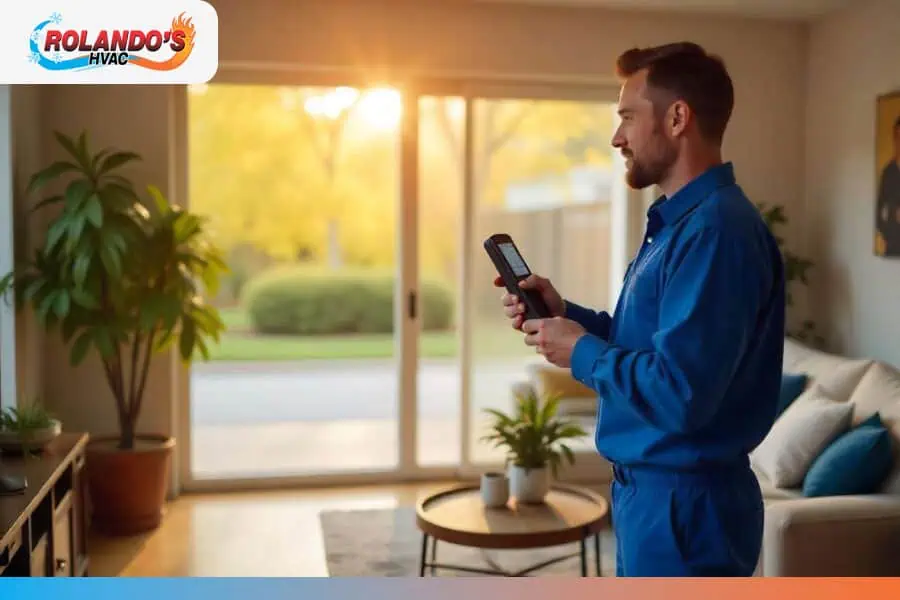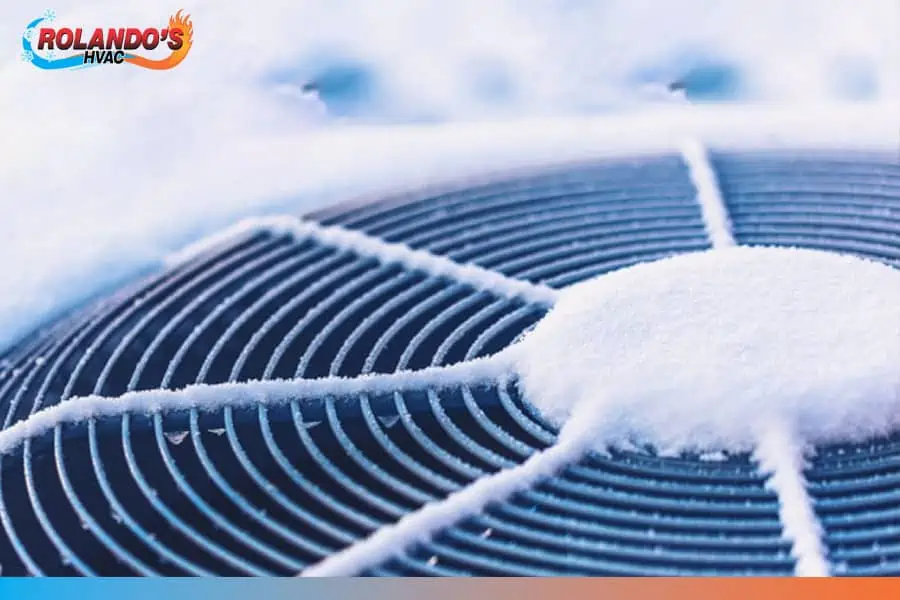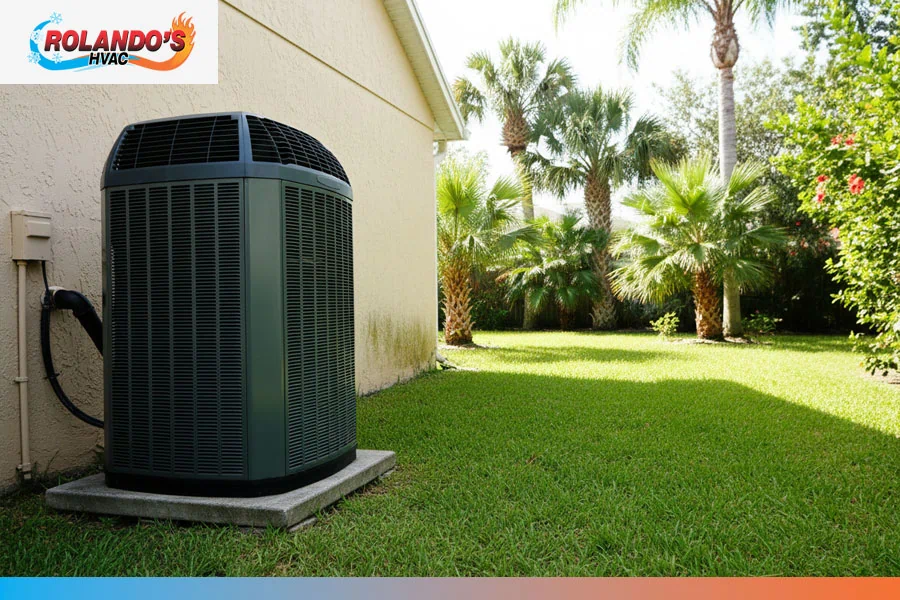
July 2, 2025
How Poor AC Efficiency Affects Your Indoor Air Quality (and What to Do About It)
In Tampa’s relentless heat and humidity, your air conditioning system does much more than cool the air. It plays a critical role in managing indoor air quality (IAQ)—from reducing allergens to controlling moisture and limiting the spread of pollutants. But when your AC isn’t running efficiently, it can have a surprising impact on your home’s health. Poor air conditioning efficiency can cause high humidity, mold growth, stale air circulation, and even increase your exposure to indoor air pollution and particulates.
This blog explores the connection between energy efficiency and air quality, outlining how your AC can support or hinder a healthy indoor environment—and what steps you can take to improve it.
Learn more about AC maintenance at Rolando’s HVAC.
Why AC Efficiency Matters for Indoor Air Quality
Your air conditioning system isn’t just about controlling temperature. It plays a critical role in indoor environmental health by managing humidity, regulating air flow, and filtering out harmful particulates and airborne pollutants. When your air conditioning unit is energy efficient, it not only saves electricity but also protects your family’s health by minimizing indoor air pollution.
The AC’s Dual Role: Cooling + Humidity Control
In Florida’s hot and humid climate, efficient air conditioning systems are essential. A well-maintained unit performs two essential tasks:
- Cools your home through the proper operation of refrigerants, compressors, and airflow systems.
- Dehumidifies the air by extracting excess moisture, reducing the risk of mold and mildew growth.
When operating at optimal levels—especially models rated with high Seasonal Energy Efficiency Ratios (SEER) or carrying the Energy Star label—your HVAC system acts as a first line of defense against common indoor air contaminants, including dust, pollen, pet dander, formaldehyde, volatile organic compounds (VOCs) from household products, and combustion gases like carbon monoxide and nitrogen dioxide.
Consequences of Poor Efficiency:
When your air conditioning system loses efficiency—due to clogged air filters, dirty evaporator coils, or inadequate maintenance—indoor air quality can deteriorate rapidly. Some of the most common health hazards associated with poor AC performance include:
- High indoor humidity: Elevated moisture levels promote indoor mold, dust mites, and bacterial growth, particularly in areas like bathrooms, basements, and kitchens. This can lead to mold-related illnesses, asthma, and chronic allergy symptoms.
- Particulate pollution: Inefficient systems allow particulates, pesticide residue, and even radon and lead particles—often released during home renovation or construction—to circulate throughout the home.
- Poor air filtration: A failing air filter allows tobacco smoke, ash, soot, and ultrafine particles from cooking, fireplaces, or nearby wildfires to persist indoors.
- Airborne pathogens: An inefficient or dirty HVAC system can aid in the airborne transmission of viruses like influenza, bacteria like Legionella, and irritants that exacerbate cough, fatigue, headaches, and shortness of breath.
- Occupational hazards at home: Home-based exposure to contaminants like asbestos, mercury, benzene, and kerosene heater fumes mirrors risks usually studied by the National Institute for Occupational Safety and Health (NIOSH) and the American Industrial Hygiene Association (AIHA).
How to Protect Your Indoor Air
To safeguard your indoor air quality, consider these best practices:
- Use HEPA or MERV-rated air filters for your HVAC system.
- Schedule regular quality air duct cleaning and HVAC inspections.
- Install a whole-home air filtration system or home air purifier with sensors for carbon dioxide, monoxide, and humidity.
- Use home humidifiers to balance moisture during dry weather and prevent drywall, furniture, and carpets from harboring contaminants.
- Ensure passive ventilation through windows or mechanical ventilation systems where necessary.
- Consider iaq testing or indoor air testing if you suspect contamination from formaldehyde, paint, plastics, or household chemicals.
- Upgrade to a 15 SEER AC unit or the most efficient mini split or high efficiency AC unit on the market to ensure cleaner air and lower electric bills.
Efficient air conditioning supports your home's comfort and your family's health. Learn more in our blog about choosing an energy efficient HVAC system that improves air quality while lowering energy use.
Read our energy-efficient air conditioner blog to learn how to improve efficiency and air quality.
Common Signs of Poor AC Efficiency (and Air Quality Risks)
Not sure if your AC is dragging down your IAQ? Here are some signs to watch out for:
| Sign of Poor AC Efficiency | Impact on Indoor Air Quality |
| High indoor humidity | Promotes mold and mildew growth |
| Musty or moldy odors | Indicates microbial contamination |
| Uneven cooling or weak airflow | Leads to stagnant air and pollutant buildup |
| Increased allergy symptoms | Suggests circulation of allergens |
| Visible dust around vents | Points to inadequate filtration |
Experiencing these problems? Check our AC troubleshooting tips to know what to look for.
How Poor AC Efficiency Worsens Humidity and Mold Risks
Tampa’s subtropical climate is a natural incubator for indoor mold. Warm temperatures, elevated humidity, and inconsistent air conditioning performance make the perfect environment for fungal growth, especially during the rainy season. When your ait conditioning system isn't working efficiently, the risk of mold, bacteria, and other indoor pollutants rises sharply—impacting your home and your health.
Inadequate Dehumidification
An inefficient air conditioner often consumes more electricity while failing to effectively reduce moisture levels. Despite longer run times, poor air filter performance, refrigerant issues, or a failing compressor can leave your home vulnerable to excessive indoor humidity. This can cause:
- Moisture on carpets, drywall, and plumbing fixtures
- Condensation on windows and walls
- The spread of volatile organic compounds (VOCs), formaldehyde, and pesticide residue
All of which contribute to air pollution, odor, and long-term structural contamination.
Moisture Buildup in Ducts and Ventilation
When ductwork lacks thermal insulation or proper ventilation, condensation can accumulate—especially in unconditioned spaces like attics, basements, or garages. This stagnant moisture can mix with dust, fibers, and particulates, creating a hazardous environment inside your HVAC system. Over time, this can lead to:
- Mold colonies inside vents and near the evaporator coil
- Growth of bacteria, mites, and allergens
- Circulation of carbon monoxide, carbon dioxide, and exhaust gases from nearby combustion sources like gas stoves, fireplaces, or furnaces
Not only does this degrade indoor air quality, but it can contribute to lung cancer, asthma, allergies, and other respiratory diseases, especially in vulnerable populations such as children, the elderly, and individuals with preexisting conditions.
Long-Term Health and Safety Risks
According to the United States Environmental Protection Agency (EPA) and supported by studies from the National Institute for Occupational Safety and Health (NIOSH) and ASHRAE, indoor mold exposure can pose serious health risks, including:
- Asthma flare-ups and allergy symptoms
- Increased risk of lung and heart complications
- Triggers for irritation of the skin, eyes, and respiratory tract
- Potential links to long-term effects like mesothelioma, lead poisoning, or asbestosis—especially during renovation or after poor pest control or construction practices
Preventing Mold with Efficient HVAC
Modern, energy-efficient HVAC systems—such as an Energy Star mini split, 15 SEER AC unit, or the most energy-efficient HVAC system—are designed to minimize indoor air pollution while lowering your electricity usage. These systems often feature:
- HEPA filters and advanced air purifiers
- Built-in sensors to detect humidity, temperature, and pollutant levels
- Smart thermostat integration for optimized energy use
- Whole-home air filtration systems and home air testing options
By investing in quality management, routine maintenance, and iaq testing, you can reduce your exposure to toxins, maintain safer air quality index levels, and help protect your family from serious mold health issues.
The Link Between Dirty AC Components and Indoor Air Quality
Neglected air conditioning systems don't just impact your comfort—they actively harm your indoor air quality and your health. When critical components go without proper maintenance, your home becomes a hub for pollutants, allergens, and even toxic gases.
- Dirty air filters: These can no longer trap dust, pollen, or pet dander, resulting in poor filtration and compromised air.
- Evaporator coils coated in grime: Not only reduce heat transfer efficiency but also encourage mold and bacteria growth on wet surfaces.
- Leaky ducts: Pull in contaminated air from attics or crawlspaces, including insulation, asbestos, and cockroach allergens.
Routine servicing also protects against toxicants like mercury, lead, and nitrogen dioxide, which can accumulate unnoticed. Whether you’re relying on a most energy efficient HVAC system, seer HVAC unit, or most efficient window AC, upkeep ensures you maintain safe air quality levels and avoid serious health complications linked to poor ventilation, airborne transmission, and combustion byproducts.
Don’t skip routine AC maintenance—it's essential for clean air and high efficiency.

How to Improve AC Efficiency and Indoor Air Quality
You don’t need to replace your entire HVAC system to breathe easier. Try these expert tips:
- Schedule seasonal maintenance and tune-ups: Catch small issues before they affect performance.
- Replace air filters regularly: Every 1–3 months, especially if you have pets or allergies.
- Seal ducts and clean coils: Boosts air flow and removes contaminants.
- Upgrade to a high-efficiency AC: Consider a high SEER (Seasonal Energy Efficiency Ratio) model, ideally Energy Star® certified.
- Smart thermostats: Improve control over temperature, humidity, and air flow for optimal comfort and efficiency.
Learn more about choosing a smart thermostat to improve energy savings and air quality.
Should You Repair or Replace an Inefficient AC?
Not sure whether to fix your old system or invest in a new one? Here’s a quick breakdown:
Repair May Be Enough If:
- Your unit is under 10 years old.
- Issues stem from dirty coils, filters, or minor electrical faults.
- Performance improves after maintenance or home air duct cleaning.
Replacement Is Smarter If:
- Your unit uses R-22 refrigerant (phased out).
- You're facing frequent breakdowns or rising energy bills.
- Your AC’s SEER rating is below 13 (modern units go up to 25+).
- You want the most energy efficient AC unit for long-term savings.
FAQ: AC Efficiency & Indoor Air Quality (Schema Block Optional)
Q: Does a poorly maintained AC cause health issues?
Yes. It can circulate dust, bacteria, mold, and carbon monoxide, all of which harm your respiratory system and overall health.
Can a high SEER, energy-efficient AC improve indoor air quality?
Absolutely. Systems with better filtration, dehumidification, and air flow reduce allergens and contaminants.
How often should I replace my air filter in Tampa?
Every 1–2 months due to high humidity, pollen, and dust levels.
What’s the best way to reduce indoor humidity?
A combination of AC maintenance, dehumidifiers, and sealing duct leaks.
Visit our AC maintenance page to learn more.
Concerned about your AC’s performance and your home’s indoor air quality?
Let Rolando’s HVAC keep your home cool, clean, and safe from pollutants, humidity, and mold.
Call (813) 373-6804 or schedule your inspection today.
Most maintenance services can be completed same-day, with financing available (subject to parts and availability).

Rolando Mojarrieta is the founder of Rolando’s HVAC, a licensed HVAC contractor based in Town ‘n’ Country and serving the greater Tampa Bay area. With over 15 years of experience in residential air conditioning, heat pump installations, and energy-saving upgrades, Rolando is committed to helping Florida homeowners stay comfortable year-round. License #CAC1820272.

December 1, 2025
Why Is My AC Freezing Up in Tampa, FL?

November 15, 2025
Heat Pump Maintenance in Lakeland, FL: Tips for Florida Homes

November 10, 2025
